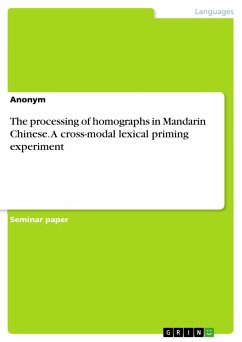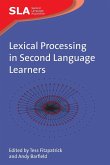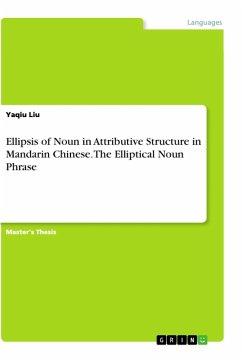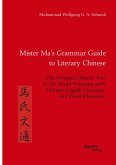Seminar paper from the year 2021 in the subject Orientalism / Sinology - Chinese / China, grade: 1,0, http://www.uni-jena.de/ (Institut für Anglistik/Amerikanistik), language: English, abstract: This paper will report a cross-modal lexical priming experiment which focuses on Mandarin homographs of varying degrees of semantic relatedness. In this experiment, the time course of context effects and the effect of semantic relatedness on lexical ambiguity resolution will be examined.The phenomenon of lexical ambiguity is one of several types of ambiguities and is pervasive in almost all natural languages. When a listener hears an ambiguous word with multiple meanings in a sentence, do they activate all meanings associated with that ambiguous word automatically regardless of the preceding context, or do they make use of the preceding context to eliminate irrelevant meanings? This is one of the fundamental empirical questions in the study of language processing, id est lexical ambiguityresolution.Two main types of models have been suggested by the research literature for this issue. The first one is the exhaustive access model, which proposes that all meanings of an ambiguous word will be accessed automatically following the occurrence of the word and that the context can only help to select the appropriate meaning at a later stage. The second contrasting model is the interactive access model, which assumes that the context can facilitate the contextually appropriate meaning of an ambiguous word at the initial stage of lexical access if the prior context provides a strong bias towards the appropriate meaning. As the literature shows, what undoubted is that the context plays an important role in the selection of a contextually appropriate meaning of the ambiguous words, the main debate lies in how early the context effects take place in the lexical processing.So far, these two models have been mostly examined in Indo-European languages, particularly in English. There has been just a scarcity of this line of research in Chinese, one of the most important East Asian languages, which differs significantly from Indo-European languages in terms of its unique psycholinguistic properties in phonological, lexical and syntactic structures. These properties can thus pose a good challenge to verify and complement the examination of these models in lexical processing from a different perspective.
Hinweis: Dieser Artikel kann nur an eine deutsche Lieferadresse ausgeliefert werden.
Hinweis: Dieser Artikel kann nur an eine deutsche Lieferadresse ausgeliefert werden.








